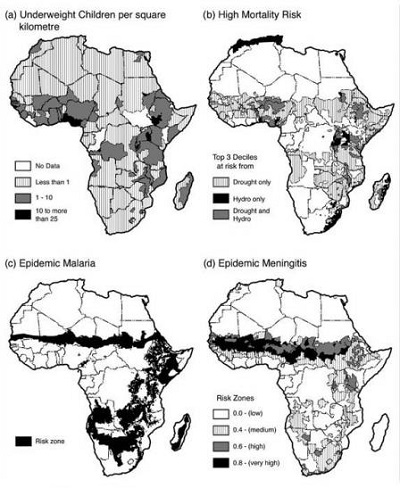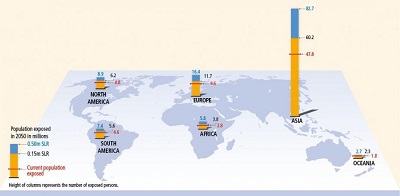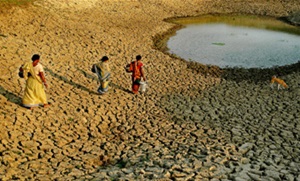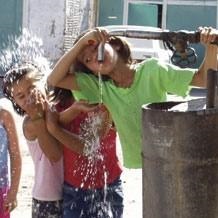|
|
| |
|
|
| |
|
|
|
|
| |
 International
Climate Impacts International
Climate Impacts
Introduction to Global Issues
Human basic needs, such as food, water, health, and shelter,
are affected by climate. Changes in climate may threaten
these needs with increased temperatures, sea level rise,
changes in precipitation, and more frequent or intense
extreme events.
Picture - Farmers need
access to weather and market information to make decisions,
especially as climate change alters historical patterns.
Source: USAID
Climate change will affect individuals and groups
differently. Certain groups of people are particularly
sensitive to climate change impacts, such as the elderly,
the infirm, children and pregnant women, native and tribal
groups, and low-income populations.
Climate change may also threaten key natural resources,
affecting water and food security. Conflicts, mass
migrations, health impacts, or environmental stresses in
other parts of the world could raise economic, health, and
national security issues for the United States.
Although climate change is an inherently global issue, the
impacts will not be felt equally across the planet. Impacts
are likely to differ in both magnitude and rate of change in
different continents, countries, and regions. Some nations
will likely experience more adverse effects than others.
Other nations may benefit from climate changes. The capacity
to adapt to climate change can influence how climate change
affects individuals, communities, countries, and the global
population.
Impacts on Basic Needs
Impacts on Agriculture and Food
Changes in climate could have significant impacts on food
production around the world. Heat stress, droughts, and
flooding events may lead to reductions in crop yields and
livestock productivity. Areas that are already affected by
drought, such as Australia and the Sahel in Africa, will
likely experience reductions in water available for
irrigation.
At middle to high latitudes, cereal crop yields are
projected to increase slightly, depending on local rates of
warming and crop type. At lower latitudes, cereal crop
yields are projected to decrease. The greatest decreases in
crop yields will likely occur in dry and tropical regions.
In some African countries, for example, wheat yields could
decline by as much as 35% by 2050.
Climate change is affecting many fisheries around the world.
Increasing ocean temperatures have shifted some marine
species to cooler waters outside of their normal range.
Fisheries are important for the food supply and economy of
many countries. For example, more than 40 million people
rely on the fish caught in the Lower Mekong delta in Asia,
which is the largest freshwater fishery in the world.
Projected reductions in water flows and increases in sea
level may negatively affect water quality and fish species
in regions like these, affecting the food supply for
communities that depend on these resources.
Climate change is very likely to affect global, regional,
and local food security by disrupting food availability,
decreasing access to food, and making utilization more
difficult. Climate risks to food security are greatest for
poor populations and in tropical regions. The potential of
climate change to affect global food security is important
for food producers and consumers in the United States.
For more information about the impacts of climate change on
agriculture and food production, please visit the
Agriculture and Food Supply Impacts & Adaptation page. |
|
 Impacts
on Water Supply and Quality Impacts
on Water Supply and Quality
Semi-arid and arid areas (such as the Mediterranean,
southern Africa, and northeastern Brazil) are particularly
vulnerable to the impacts of climate change on water supply.
Over the next century, these areas will likely experience
decreases in water resources, especially in areas that are
already water-stressed due to droughts, population
pressures, and water resource extraction.
Picture - Areas in
Africa currently at risk for (a) hunger, (b) natural
hazard-related disaster risks, (c) malaria (derived from
historical rainfall and temperature data [1950-1996]), and
(d) epidemics of meningococcal meningitis (based on epidemic
experience, relative humidity [1961-1990] and land cover).
Source: IPCC (2007)
As climate changes, water is very likely to become scarce at
least part of the time in many areas, but more plentiful
part of the time in some areas as well. The availability of
water is strongly related to the amount and timing of runoff
and precipitation. With a 2.7°F rise in global mean
temperature, annual average streamflow is projected to
increase by 10-50% at high latitudes and in some wet
tropical areas, but decrease by 10-50% in some dry regions
at mid-latitudes and in the subtropics. As temperatures
rise, snowpack is declining in many regions and glaciers are
melting at unprecedented rates, making water less available
in areas that depend on it from melting snow and glaciers
during spring and summer. Droughts are likely to become more
widespread. When it does rain, more precipitation is
expected to fall in extreme heavy precipitation events.
Increases in heavy precipitation events would not increase
water supply, but instead result in increased flooding,
except in river basins with large dams able to hold excess
water until it is needed. |
 Water
quality is important for ecosystems, human health and
sanitation, agriculture, and other purposes. Increases in
temperature, changes in precipitation, sea level rise, and
extreme events could diminish water quality in many regions.
Large rainstorms may cause large amounts of pollutants to
enter rivers and estuaries, as excess water may overwhelm
wastewater systems and natural buffers. Increased pollution
as well as increasing water temperatures can cause algal
blooms and potentially increase bacteria in water bodies. In
coastal areas and small islands, saltwater from rising sea
level and storm surges threaten water supplies. These
impacts may require communities to begin treating their
water in order to provide safe water resources for human
uses. Water
quality is important for ecosystems, human health and
sanitation, agriculture, and other purposes. Increases in
temperature, changes in precipitation, sea level rise, and
extreme events could diminish water quality in many regions.
Large rainstorms may cause large amounts of pollutants to
enter rivers and estuaries, as excess water may overwhelm
wastewater systems and natural buffers. Increased pollution
as well as increasing water temperatures can cause algal
blooms and potentially increase bacteria in water bodies. In
coastal areas and small islands, saltwater from rising sea
level and storm surges threaten water supplies. These
impacts may require communities to begin treating their
water in order to provide safe water resources for human
uses.
Picture - Indus River
in Southern Pakistan (Left: August 2009; Right: August
2010). In August 2010, record monsoon rains flooded
significant portions of Pakistan. Twenty percent of the
country was underwater as a result of the floods, affecting
about 20 million Pakistanis and rendering six million
homeless. In the image from 2009, the Indus is about 0.6
miles wide. In the 2010 image, the river is 14 miles wide or
more in parts. Source: NASA (2010)
For more information about the impacts of climate change on
the water supply, please visit the Water Impacts &
Adaptation page.
Impacts on Human Health
The risks of climate-sensitive diseases and health impacts
can be high in countries that have little capacity to
prevent and treat illness. There are many examples of health
impacts related to climate change.
Increases in temperatures are linked to more frequent and
severe heat stress.
Worsened air quality that often accompanies heat waves or
wildfires can lead to breathing problems and exacerbate
respiratory and cardiovascular diseases.
Impacts of climate change on agriculture and other food
systems can increase rates of malnutrition and foodborne
illnesses.
Climate changes can influence infectious diseases. The
spread of meningococcal (epidemic) meningitis is often
linked to climate changes, especially drought. Areas of
sub-Saharan and West Africa are sensitive to the spread of
meningitis, and will be particularly at-risk if droughts
become more frequent and severe.
The spread of mosquito-borne diseases such as malaria,
dengue, and West Nile virus may increase in areas projected
to receive more precipitation and flooding. Increases in
rainfall and temperature can cause spreading of dengue
fever.
Changes in precipitation patters and extreme weather events
can lead to cascading health impacts, particularly when
power, water, or transportation systems are disrupted.
Diarrheal diseases from contaminated water and food sources
are a major concern, particularly for children.
The effects of global climate change on mental health and
well-being are integral parts of the overall climate-related
human health impacts. Mental health consequences of climate
change range from minimal stress and distress symptoms to
clinical disorders, such as anxiety, depression,
post-traumatic stress, and suicidal thoughts.
Certain groups of people in low-income countries are
especially at risk for adverse health effects from climate
change. These at-risk groups include urban people living in
poverty, older adults, young children, traditional
societies, subsistence farmers, and coastal populations.
Many regions, such as Europe, South Asia, Australia, and
North America, have experienced heat-related health impacts.
Rural populations, older adults, outdoor workers, and those
without access to air conditioning are often the most
vulnerable to heat-related illness and death. For more
information about the climate impacts on vulnerable
populations, please visit the Society Impacts & Adaptation
page. |
|
|
 Impacts
on Shelter Impacts
on Shelter
Climate change affects the migration of people within and
between countries around the world. A variety of reasons may
force people to migrate into other areas. These reasons
include conflicts, such as ethnic or resource conflicts,
degraded ecosystem services, such as lack of viable
agricultural land or fresh water, and extreme events, such
as flooding, drought, and hurricanes. Extreme events
displace many people, especially in areas that do not have
the ability or resources to quickly respond or rebuild after
disasters. Many types of extreme events are becoming more
frequent or severe because of climate change, which
exacerbates existing conflicts. This will likely increase
the numbers of people migrating during and after these types
of events.
Picture - For
low-elevation coastal areas, this graphic projects current
and future population exposure to inundation due to a
1-in-100 year extreme event with sea level rise of 0.15 m
(.5 ft, low emissions scenario) to 0.50 m (1.6 ft, high
emissions scenario, due to partial melting of Greenland and
West Antartic Ice Sheets. IPCC (2014)
Coastal settlements and low-lying areas are particularly
vulnerable to climate change impacts, such as sea level
rise, erosion, and extreme storms. Rising ocean temperatures
and acidity may also threaten coastal ecosystems. As coastal
habitats (such as barrier islands, wetlands, deltas, and
estuaries) are destroyed, coastal settlements can become
more vulnerable to flooding from storm surges and erosion.
Both developing and developed countries are vulnerable to
the impacts of sea level rise. For example, Bangladesh, the
Netherlands, and Guyana are particularly at-risk.
For more information about the impacts of climate change on
coastal areas, please visit the Coastal Impacts & Adaptation
page. |
|
|
 Impacts
on Vulnerable Populations Impacts
on Vulnerable Populations
Indigenous groups in various regions--such as the United
States, Latin and South America, Europe, and Africa--are
already experiencing threats to their traditional
livelihoods. Rising sea levels and extreme events threaten
native groups that inhabit low-lying island nations. Higher
temperatures and reduced snow, ice, and permafrost threaten
groups that live in mountainous and polar areas. Climate
effects in these areas can affect hunting, fishing,
transport, and other activities.
Picture - Three women
reach their water source, a low water level lake in India.
Photo Credit: 2006, Joydeep Mukherjee, Courtesy of
Photoshare. Source: USAID
Approximately 1.4 billion people, close to one fifth of the
world’s population, live below the World Bank's measure of
extreme poverty, earning less than US $1.25 a day. Many
lower-income groups depend on publicly provided resources
and services such as water, energy, and transportation.
Extreme events can affect and disrupt these resources and
services, sometimes beyond replacement or repair. Many
people in lower-income countries cannot afford or gain
access to adaptation mechanisms such as air conditioning,
heating, or disaster insurance. This lack of adaptive
capacity makes the world’s poor especially vulnerable to the
impacts of climate extremes, exacerbating existing
conditions of poverty and inequality, and ultimately leading
to more poverty.
Older and younger people are also especially sensitive to
climate change impacts. Children's developing immune,
respiratory, and neurological systems make them more
sensitive to some climate change impacts, including more
frequent or severe extreme events, increased heat, and
worsened air quality. Elderly populations are also at risk
due to frail health and limited mobility. Extreme heat and
storm events can disproportionately affect older people.
Climate change impacts can differ according to gender.
Worldwide, women have a higher rate of mortality than men
from severe storms or other extreme events, although there
is regional variation. In some regions, working-age men who
work outdoors are more vulnerable to heat-related deaths.
Women developing countries women may be particularly
vulnerable to extreme events due to differences in poverty
and physical vulnerability due to undernutrition or
pregnancy. As climate change causes extreme events to become
more frequent or severe, women may be disproportionately
affected. |
|
|
 Impacts
on National Security Impacts
on National Security
Climate change impacts are expected to exacerbate national
security issues and increase the number of international
conflicts. The Department of Defense reports that climate
change is likely cause instability in other countries--
impairing access to food and water, damaging infrastructure,
spreading disease, uprooting and displacing large numbers of
people—which also affects the United States. They report:
“Climate change will affect the Department of Defense's
ability to defend the Nation and poses immediate risks to
U.S. National security.”
Picture - Water
scarcity led to tensions in southern Kazakhstan. USAID
responded by increasing access to drinking water and
irrigation. Source: USAID
Many concerns revolve around the use of natural resources,
such as water. In many parts of the world, water issues
cross local and national borders. Access to consistent and
reliable sources of water in these regions is greatly
valued. Changes in the timing and intensity of rainfall
would threaten already limited water sources and potentially
cause future conflicts. Evidence suggests most conflict is
likely to occur between local communities, socioeconomic
groups, and states, while bilateral and multilateral
interactions have shown evidence of formal cooperation over
resources.
Threatened food security in parts of Asia and sub-Saharan
Africa could also lead to conflict. Rapid population growth
and changes in precipitation and temperature, among other
factors, are already affecting crop yields. Resulting food
shortages could increase the risk of humanitarian crises and
trigger population migration across national borders,
ultimately sparking political instability.
The ongoing loss of the ice cover in the Arctic Ocean is
very likely to have with national security implications. The
Arctic Ocean has a long history of modest, though growing,
shipping activity, including trans-Arctic shipping routes.
Declining sea ice coverage will allow more access to these
waters. However, a number of other international issues will
influence the potential growth in shipping. In the case of
the Arctic Ocean, increasing access to these waters means
that issues of sovereignty (priority in control over an
area), security (responsibility for policing the
passageways), environmental protection (control of
ship-based air and water pollution, noise, or ship strikes
of whales), and safety (responsibility for rescue and
response) will become more important. |
|
Regional Impacts
Highlights of recent and projected regional impacts are
shown below.
Impacts on Africa
Africa may be the most vulnerable continent to climate
variability and change because of multiple existing stresses
and low adaptive capacity. Existing stresses include
poverty, food insecurity, political conflicts, and ecosystem
degradation.
By 2050, between 350 million and 600 million people are
projected to experience increased water stress due to
climate change. Urban population is also projected to
triple, increasing by 800 million people, complicating urban
poverty and access to basic services.
Climate variability and change is projected to severely
compromise agricultural production, including access to
food, in many African countries and regions.
Toward the end of the 21st century, projected sea level rise
will likely affect low-lying coastal areas with large
populations, including Senegal, Liberia, and Mozambique.
Climate variability and change can negatively impact human
health. In many African countries, existing health threats –
such as malnutrition, malaria and other vector-borne
diseases -- can be exacerbated by climate change.
Impacts on Asia
Glaciers in Asia are retreating at faster rates than ever
documented in historical records. Some glaciers currently
cover 20% of the land that they covered a century ago.
Melting glaciers increase the risks of flooding and rock
avalanches from destabilized slopes.
Climate change is projected to decrease freshwater
availability, especially in central and southeast Asia,
particularly in large river basins. With population growth
and increasing demand from higher standards of living, this
decrease could adversely affect more than a billion people
by 2050.
Increased flooding from the sea and, in some cases, from
rivers threatens coastal areas, especially heavily populated
delta regions in south and southeast Asia.
The impacts of climate change on crop yields are likely to
vary drastically depending on region, crop type, and
regional changes in temperature and precipitation. For
example, by the mid-21st century, climate change could
increase crop yield up to 20% in east and southeast Asia,
while decreasing yield up to 30% in central and south Asia.
Sickness and death due to diarrheal disease will likely
increase in east, south, and southeast Asia due to projected
changes in the hydrological cycle associated with climate
change.
Impacts on Australia and New Zealand
Water security problems are projected to intensify with a
1°C global average warming in southwestern and southeastern
Australia, and in the northern and some eastern parts of New
Zealand.
Biodiversity within some ecologically rich sites, including
the Great Barrier Reef and Queensland Wet Tropics, will be
at significant risk by 2050.
Sea level rise and more severe storms and coastal flooding
will continue to affect coastal areas. Coastal development
and population growth in areas such as Cairns and Southeast
Queensland (Australia) and Northland to Bay of Plenty (New
Zealand), would place more people and infrastructure at
risk.
Increased drought and fire are projected to cause declines
in agricultural and forestry production over much of
southern Australia and the northern and eastern parts of New
Zealand.
Cascading and interacting economic, social, and daily life
circumstances have accompanied prolonged drought in rural
regions. Drought-related worry and psychological distress
increased in drought-declared Australian regions,
particularly for those experiencing loss of livelihood and
industry. Long-term drought has been linked to increased
incidence of suicide among male farmers in Australia.
Extreme storm events are likely to increase the failure of
dikes, levees, drainage, and sewerage systems. They are also
likely to increase the damage from storms and fires.
More heat waves are likely to cause more deaths and more
electrical blackouts.
Indigenous populations are more exposed the risks of climate
change than most other Australians and New Zealanders.
Impacts on Europe
Wide-ranging impacts of climate change are already being
documented in Europe, including retreating glaciers, sea
level rise, longer growing seasons, species range shifts,
and heat wave-related health impacts.
Future impacts of climate change will likely negatively
affect nearly all European regions, with adverse social,
health, and infrastructure effects. Many economic sectors,
such as agriculture and energy, could face challenges.
In southern Europe, higher temperatures and drought may
reduce water availability, hydropower potential, summer
tourism, and crop productivity, hampering economic activity
more than other European regions.
In central and eastern Europe, summer precipitation is
projected to decrease, causing higher water stress. Forest
productivity is projected to decline. The frequency of
peatland fires is projected to increase.
In northern Europe, climate change is initially projected to
bring mixed effects, including some benefits such as reduced
demand for heating, increased crop yields, and increased
forest growth. However, as climate change continues,
negative impacts are likely to outweigh benefits. These
include more frequent winter floods, endangered ecosystems,
and increasing ground instability from thawing permafrost.
Impacts on Central and South America
By mid-century, increases in temperature and decreases in
soil moisture are projected to cause savanna to gradually
replace tropical forest in eastern Amazonia.
In drier areas, climate change will likely worsen drought,
leading to salinization (increased salt content) and
desertification (land degradation) of agricultural land. The
productivity of livestock and some important crops such as
maize and coffee is projected to decrease in some areas,
with adverse consequences for food security. In temperate
zones, soybean yields are projected to increase.
Sea level rise is projected to increase risk of flooding,
displacement of people, salinization of drinking water
resources, and coastal erosion in low-lying areas. These
risks threaten fish stocks, recreation, and tourism.
Changes in precipitation patterns and the melting of
glaciers are projected to significantly affect water
availability for human consumption, agriculture, and energy
generation.
Climate change and land use changes are expected to increase
the rates of species extinction.
Warmer weather, milder winters, and changes in precipitation
may increase incidence of some vector-borne diseases, such
as the chikungunya virus, which is transmitted by
mosquitoes.
Impacts on North America
Warming in western mountains will decrease snowpack,
increase winter flooding, and reduce summer flows,
exacerbating competition for over-allocated water resources.
Disturbances from pests, diseases, and fire are projected to
increasingly affect forests, with extended periods of high
fire risk and large increases in area burned.
Moderate climate change in the early decades of the century
is projected to increase aggregate yields of rain-fed
agriculture in northern areas, but temperature increases
will reduce corn, soy, and cotton yields in the Midwest and
South by 2020. Crops that are near the warm end of their
suitable range or that depend on highly utilized water
resources will likely face major challenges. High emissions
scenarios project reductions in yields by as much as 80% by
the end of the century.
Increases in the number, intensity, and duration of heat
waves during the course of the century are projected to
further challenge cities that currently experience heat
waves, with potential for adverse health impacts and
increased stress on energy systems. Older populations are
most at risk.
Climate change will likely increasingly stress coastal
communities and habitats, worsening the existing stresses of
population, development, and pollution on infrastructure,
human health, and the ecosystem.
Impacts on Polar Regions
Climate changes will likely reduce the thickness and extent
of glaciers and ice sheets.
Changes in natural ecosystems will likely have detrimental
effects on many organisms including migratory birds,
mammals, and higher predators as marine species shift their
ranges.
In the Arctic, climate changes will likely reduce the extent
of sea ice and permafrost, which can have mixed effects on
human settlements. Negative impacts could include damage to
infrastructure and changes to winter activities such as ice
fishing and ice road transportation. Positive impacts could
include more navigable northern sea routes.
The reduction and thawing of permafrost, sea level rise, and
stronger storms may worsen coastal erosion and disrupt both
natural and social systems.
Climate change effects—such as increases in coastal erosion,
changes in the ranges of some fish, increased weather
unpredictability—are already disrupting traditional hunting
and subsistence practices of indigenous Arctic communities,
and may force relocation of villages.
Terrestrial and marine ecosystems and habitats are projected
to be at risk to invasive species, as climatic barriers are
lowered in both polar regions.
Impacts on Small Islands
Small islands, whether located in the tropics or higher
latitudes, are highly vulnerable to extreme weather events,
changes in sea level, increases in air and surface
temperatures, and changing rainfall patterns.
Deterioration in coastal conditions, such as beach erosion
and coral bleaching, will likely affect local resources such
as fisheries, as well as the value of tourism destinations.
Sea level rise is projected to worsen inundation, storm
surge, erosion, and other coastal hazards. These impacts
would threaten vital infrastructure, settlements, and
facilities that support the livelihood of island
communities.
By mid-century, on many small islands (such as the Caribbean
and Pacific), climate change is projected to reduce already
limited water resources to the point that they become
insufficient to meet demand during low-rainfall periods.
Invasion by non-native species is projected to increase with
higher temperatures, particularly in mid- and high-latitude
islands. |
|
|
EPA Page |
|
This is the
EPA page for this topic. To see if the Trump
administration has changed the EPA page, simply click the
link and compare the information with this page. If you
notice changes were made to the EPA page, please post a
comment. Thanks. |
|
|
Key Points
Countries around the world will likely face climate change
impacts that affect a wide variety of sectors, from water
resources to human health to ecosystems.
Impacts will vary by region and by population.
Many people in developing countries are more vulnerable to
climate change impacts than people in developed countries.
Impacts across the globe can have economic, health, and
national security implications for the United States and
other nations.
Megacities
For the first time in human history, more people are living
in cities than in rural areas. The term "megacities" refers
to cities with populations over 10 million. Fifteen of the
world's 20 megacities are threatened by sea level rise and
increased coastal storm surges. A 2010 study by the Asian
Development Bank, the World Bank, and the Japan
International Cooperation Agency looked at the effects of
climate change on three of Asia's megacities. The study
estimated that 26% of the population in Ho Chi Minh City is
currently affected by extreme storm events. By 2050, this
number could climb to more than 60%. In Manila, a major
flood under a worst-case scenario could result in the loss
of nearly a quarter of the gross domestic product (GDP) of
the metropolitan area. Manila faces not only sea level rise
and extreme rainfall events but also typhoons. The study
concluded that such climate-related risks must be an
integral part of city and regional planning for vulnerable
megacities. |
|
|
|
|
|
|
|
|
|
|
|
|
Additional Climate Change Information |
Climate Change and Carbon Dioxide
(Beginner - Listening,
reading)
A video lesson to
help with your understanding of climate change
and carbon dioxide.
The English is
spoken at 75% of normal speed.
Great English listening and reading practice. |
Carbon Dioxide and Climate Change
(Beginner - Listening,
reading)
A video lesson to
help with your understanding of carbon dioxide
and climate change.
The English is
spoken at 75% of normal speed.
Great English listening and reading practice. |
Environmental Group Warns Earth's Health at Risk
(Beginner - Listening,
reading)
A video lesson to
help with your understanding of climate change.
The English is
spoken at 75% of normal speed.
Great English listening and reading practice.
A report by the World Wildlife Fund looked at thousands of animal populations
and found they have dropped significantly in 40 years. |
Sea Levels Rising at Fastest Rate in 3,000 years
(Beginner - Listening,
reading)
A video lesson to
help with your understanding of climate change.
The English is
spoken at 75% of normal speed.
Great English listening and reading practice.
A group of scientists say sea levels are rising at record rates. Another group
found that January temperatures in the Arctic reached a record high. |
Capturing CO2 Gas Is Not Easy
(Beginner - Listening,
reading)
A video lesson to
help with your understanding of climate change.
The English is
spoken at 75% of normal speed.
Great English listening and reading practice.
Most scientists agree that carbon-dioxide gas is partly to blame for climate
change: rising global temperatures. But capturing the CO2 gas released by power
stations is costly and difficult. |
Growth, Climate Change Threaten African Plants and
Animals
(Beginner - Listening,
reading)
A video lesson to
help with your understanding of climate change.
The English is
spoken at 75% of normal speed.
Great English listening and reading practice.
Researchers believe Africa may lose as much as 30 percent of its animal and
plant species by the end of this century. |
|
|
|
|
Search Fun Easy English |
|
|
|
|
|
|
|
|
|
|
|
|
|
|
|
About
Contact
Copyright
Resources
Site Map |